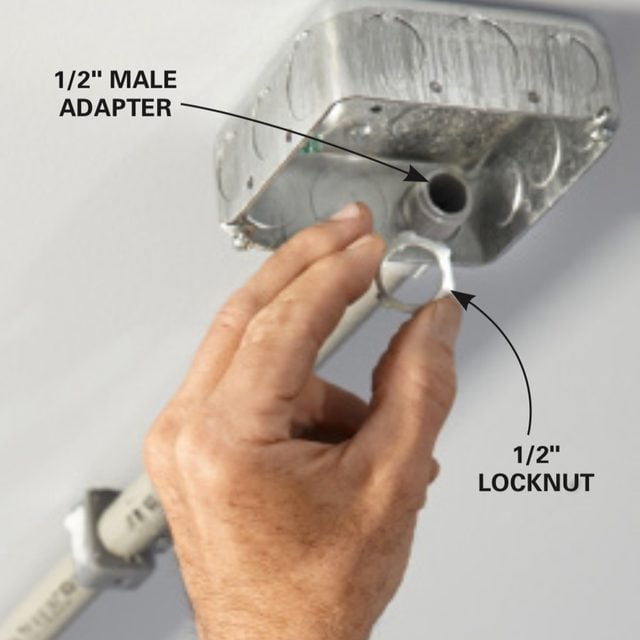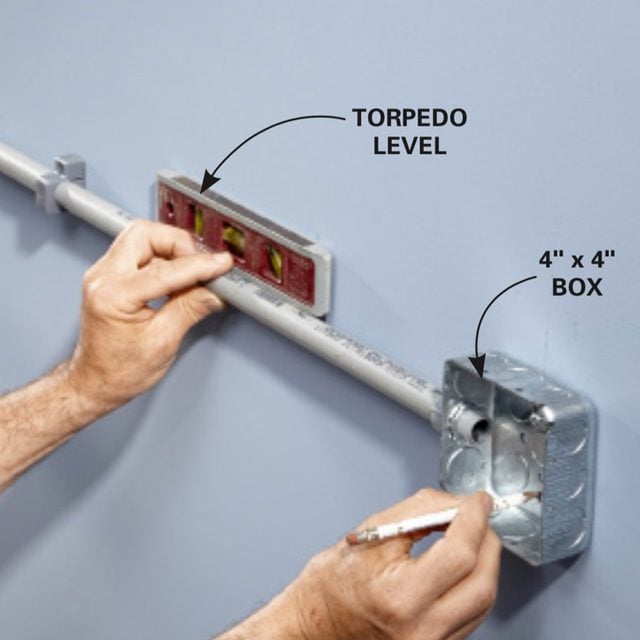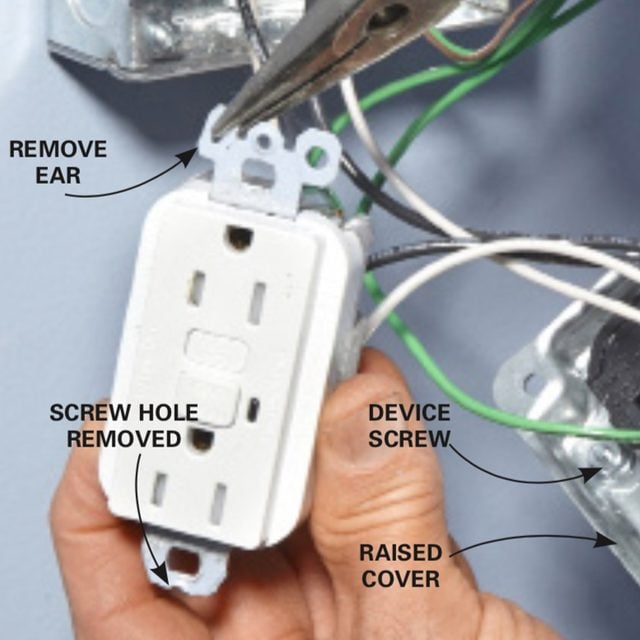Upgrade your garage wiring the correct and easy way. We'll show you how to add outlets to a garage without any disruptions to your walls in this how-to guide.
Multiple Days
Intermediate
$101–250
Introduction
Upgrade your garage wiring the correct and easy way. We'll show you how to add outlets to a garage without any disruptions to your walls in this how-to guide.
Let there be light! And more fixtures, too!
In our garage, we extended conduit from an outlet to add outlets and a hanging fixture over our workbench area. We also removed a ceiling light fixture and extended garage wiring from it to install eight new fluorescent fixtures. Remember, though, your existing wiring may not be adequate for large power tools like saws or power-hungry appliances like refrigerators or freezers. For these you may have to add a new circuit, a project we won’t cover in this story.
First we’ll show you how to prepare for installing PVC conduit by adding an extender to your electrical box. Then we’ll show you how easy it is to cut and install PVC conduit and push wire through it. Finally we’ll show you how to hook up the outlets and lights and make sure everything is properly grounded.
Installing the PVC is simple, but you’ll need a basic understanding of electrical wiring to safely connect the wires. We’ll show you how we wired our outlets, switch and lights, but if your wiring is different and you’re not sure how to make the connections, consult a wiring manual or get advice from an electrician. Whatever you do, pull a permit so an inspector can check your work.
If you have aluminum wiring, don’t work on it yourself. The connections require special techniques. Call in a licensed electrician who is certified to work with it. For more information, go to cpsc.gov and search for “aluminum wiring”.
Plan the system
The first step is to draw up a simple sketch and figure out how many outlets and lights you plan to add. Keep in mind that there is a limit to how many lights you can add to one circuit. The maximum number of fixtures is determined by the capacity of the circuit, assuming there is nothing else on the circuit that would be turned on at the same time. The maximum wattage of electrical load that can be turned on continuously for three or more hours is 1,440 watts on a 15-amp circuit and 1,920 watts on a 20-amp circuit (which includes a 20 percent reduction for safety).
When your plan is complete, make a list of the materials you’ll need. Below is a list of the parts we used for this project. Use this as a guide for making your own list. If you need a single-gang to 4-in. square steel box extender like the one we used, you may have to special-order it or pick it up at an electrical supplier. Also, match the wire gauge to your circuit. Buy 14-gauge wire if your circuit is protected by a 15-amp circuit breaker and 12-gauge wire if it’s protected by a 20-amp circuit breaker.
It’s easy with PVC conduit

You’ll find a variety of PVC fittings that let you turn corners and run the conduit exactly where you want it.
To add lights and outlets, you could spend days crawling around your attic and snaking wire through walls. But running wire through PVC conduit mounted on walls and ceilings makes the job faster and a whole lot less frustrating.
At home centers, you’ll find a variety of PVC fittings that let you turn corners and run the conduit exactly where you want it; no need to learn the art of bending conduit as there would be with metal. And unlike metal, PVC plastic is quick and easy to cut. If you goof up, you can cut out your mistake and add new parts using couplings. It couldn’t be simpler. And conduit makes your wiring more versatile because you can always add to or reconfigure the wiring later.
Tools Required
- Chalk line
- Cordless drill
- Drill bit set
- Drill/driver - cordless
- Electrical tape
- Extension cord
- Framing square
- Hammer
- Hearing protection
- Lineman's pliers
- Locking pliers
- Miter saw
- Nippers
- Non-contact voltage tester
- Pliers
- Safety glasses
- Screw gun
- Shop vacuum
- Slip joint pliers
- Stepladder
- Stud finder
- Tape measure
- Utility knife
- Voltage tester
- Wire stripper/cutter
Materials Required
- 1/2-in. PVC couplings
- 1/2-in. PVC male adapters
- 1/2-in.electrical connector locknuts
- 1/4-20 x 3-in. two-piece toggle bolts
- 10-ft. lengths of 1/2-in.
- 15-amp receptacles
- 15-amp single-pole switch
- 4-in. square raised covers
- 4-in. square x 1-1/2-in.-deep metal boxes
- 90-degree PVC bend with hub
- Black THHN 14-gauge*
- Box extender (Raco 187 or similar)
- Bulbs or tubes
- Container of PVC electrical conduit glue
- Green ground screws
- Green THHN 14-gauge*
- Light fixtures
- PVC conduit
- Screw-in drywall anchors
- Straps for 1/2-in. PVC
- Use 12-gauge wire for 20-amp circuits
- White THHN 14-gauge*
- Wire connectors
Project step-by-step (16)
Working with PVC
Glue the adapters to the conduit

Cut the conduit and remove any burrs from the inside of the cut end. Swab PVC cement around the inside of the adapter. Press the adapter onto the pipe, twist it about a quarter turn and hold for a few seconds until the glue sets.
Lock conduit to boxes

Once boxes are screwed in place, the conduit will stay put, so it’s tempting to skip or forget the locknuts. Don’t. Every male fitting needs a nut.
Secure the new conduit with a strap

Position the anchor and drive a screw through it. If you don’t hit a stud, move the strap aside and add a screw-in drywall anchor as shown here. Then screw the strap to the anchor.
There are several surface wiring methods, including metal conduit, but we chose PVC conduit because it’s inexpensive and easy to work with. You can buy compatible PVC electrical boxes, but at most home centers the selection is limited, so we chose to use metal boxes instead. Combining metal boxes and PVC conduit is fine, but unlike an all-metal system, PVC requires you to run a separate ground wire and bond it to each metal box or light fixture with either a screw or a special grounding clip.
There are a few different techniques for measuring PVC. You can measure between boxes and subtract for the fittings (Photo 5). Or you can install a bend or fitting on one end and mark the other end for cutting (Photo 3). Then it’s simple to cut the pipe. We bought a PVC Conduit Cutter (available at home centers or hardware stores), but you can also use any fine-tooth saw or even a miter saw. After you cut the conduit, ream the inside of the cut edge with a knife or pliers handle to remove any plastic burrs.
Join the conduit to fittings with special PVC cement made for electrical PVC conduit (Photo 1). Use PVC male adapters and metal locknuts to connect the PVC conduit to metal boxes (Photo 2).
You can heat and bend PVC pipe, but we don’t show how here. Instead we used 90-degree bend fittings to turn corners. You can also buy offsets that position the PVC flush to the wall surface, but these aren’t necessary if you use the type of straps we show in Photo 3.
Straps for 1/2-in. PVC must be within 36 in. of electrical boxes and spaced a maximum of 36 in. between straps. There are at least two types of straps. We like the “snap-strap” shown in Photo 3. Drive a screw through the hole to hold the strap. If you don’t hit a stud or something else solid, back out the screw, move the strap aside and drive in a drywall anchor (Photo 3) to secure the strap.
Add outlets and a light over your work
Make sure the power is off

Hold a noncontact voltage tester near each wire to make sure the power is off before you do any work on the wiring.
First turn off the circuit breaker to the outlet. Use a voltage tester to make sure the power is off. Then carefully remove the outlet—in our case it’s a GFCI outlet—and as a final precaution, test all the wires in the box with a noncontact voltage detector (Photo 4).
If you’re planning to hang a plug-in ceiling light like ours over your workbench, first find the center of your workbench. Then measure the fixture you plan to use to determine how far apart the hanging chains are. Plan to position the ceiling outlet directly above where the power cord leaves the light fixture. Then position the outlet and switch on the wall directly under the ceiling box location.
Run the conduit
Measure for conduit

Screw a box extender to the existing electrical box. Then hold the next box in position and measure between them. Subtract 1/2 in. for the male adapters to determine the length of conduit needed.
Mount the next box

Extend the piece of conduit between the two boxes. Hold it level and mark two holes in the back of the second box. Remove the box and install drywall anchors so you can mount the box to the wall.
Mark the vertical conduit

Connect a 90-degree bend to the conduit. Hold it against the ceiling and mark the top edge of the electrical box on the conduit. Subtract 1/4 in. and cut the conduit.
To get started, screw a metal box extender to the outlet box. We used a single-gang to 4-in. square box extender. You’ll run conduit from here to the next box. Hold the next outlet box in position and measure between the boxes. Subtract 1/2 in. to get the length of PVC conduit needed (Photo 5). Cut the conduit and glue male adapters to each end.
Remove the round knockouts from the metal boxes by bending them out a little, and then grabbing and twisting them with pliers. Remember to remove the smaller knockouts, not the large ones. Photo 6 shows how to mark for fastening the box. Drive screws at the marks to see if you hit solid wood. If not, remove the screws and install drywall anchors. Connect the two boxes with the PVC conduit and screw the locknuts onto the male adapters in each box. Then screw the second box to the wall. Finally, add the required clamps. If you want to add more outlet boxes, just repeat this process.
Photo 7 above shows how to determine the length of the section of vertical PVC conduit running to the ceiling-mounted box. After marking the conduit, cut it, glue on the male adapter, and connect it to the box. Use a level to plumb this section of conduit and secure it to the wall with straps. Finally, add the last section of conduit on the ceiling and anchor the ceiling box to framing or with drywall anchors (Photo 2).
Run wire and make the connections
Push wires into the conduit

Hang the wire spools on a steel pipe or dowel so they can spin freely. Bend the ends of the wires over so they don’’t catch on edges inside fittings, and then push them through the conduit.
Attach the outlets to the raised cover

Break off the ears and cut off the screw hole to prepare the outlets for mounting. Attach them to the raised cover with the included device screws.
All of our conduit runs were fairly short, and we used solid copper rather than stranded wire, so we were able to simply push the wire through the conduit (Photo 8). If you have longer runs, you may have to first push an electrical fish tape through the conduit and secure the wires to it so you can pull them through.
For a wiring scenario like we show here, you’ll need separate hot (black), neutral (white) and ground (green) wires. Leave about a foot of extra wire at each box.
After you’ve run the wires to each box, you can start making the connections. We’re providing ground-fault protection to the outlets and light fixture by connecting them to the “load” side of the GFCI receptacle in the first box. Double-check to make sure the power is still off. Figures A, B and C below show the wiring diagrams to add outlets and a switched outlet for a hanging light. While you’re at it, check out these garage lighting ideas.
It’s important to make sure all the boxes are grounded. Do this by connecting the new (green) ground wire to the existing ground wire at the first box (see “Ground Metal Boxes and Fixtures,” below). Then connect the new ground wire to every metal box with a grounding screw. Photo 9 shows how to mount the outlets and switches to the raised cover using the included device screws. Attach the raised covers to the metal boxes with the included machine screws and you’re ready to turn on the power and test your work. Use a plug-in GFCI outlet tester at each outlet to make sure your connections are correct.
Ground metal boxes and fixtures

Since PVC conduit doesn’t conduct electricity, you’ll run a separate ground wire through the conduit. This ground wire must be firmly attached to every metal box and light fixture connected by the conduit with either a grounding screw or a special grounding clip.
Add fluorescent lights
Cut an access hole

Start with a hole in the middle to get the snips started. Our fixture had a knockout that we removed. Otherwise, use a small hole saw to drill a starting hole. Snip out to the circle and follow it with the snips.

Hang the second fixture with the conduit already attached. There’s no easy way to insert straight runs of conduit between fixtures that are already fastened to the ceiling.
Connect parallel fixtures

Connect a 90-degree bend to a length of conduit. Install a 90-degree bend on the second fixture. Hold the conduit with the attached bend in position. Mark the conduit and cut it to length.
Ground the light fixture

Add a ground screw to the light fixture and loop the ground wire around it. Tighten the screw.
Connect the fixture wires

Strip the ends of the new wires and connect them to the wires in the fixture. Connect all neutral white wires together. Connect the colored fixture wire to the black wires.
Install the cover

Finish the lighting installation by snapping the cover under the tabs. Then add the fluorescent lamps. Our fixtures also included a prismatic lens that we snapped on to complete the project.
Start by making sure the circuit breaker for the existing light is turned off. Then remove the light fixture and check the wires in the box with a noncontact voltage tester. If the electrical box is in the right location, you can start by adding a fluorescent fixture over the box.
Photo 10 above shows how to prepare the fixture. The diameter of the hole you cut can be smaller than the electrical box, but should be large enough to reach through to access the wires in the box. After you cut the hole, smooth the edges with a file to remove sharp edges and burrs.
If your preferred location for the lights is not lined up with the ceiling box, then start by adding a box extender to the existing ceiling light box (Photo 7). Then extend conduit to the first fixture.
You can install ceiling fixtures by screwing them directly to the wood framing above or hanging them from toggle bolts. To use toggle bolts, transfer measurements from the mounting holes in the light fixture to the ceiling and drill 1/2-in. holes in the drywall. Then install toggle bolts on the fixture and simply push them into the holes as you hold the fixture next to the ceiling (Photo 12). Measure, use a laser or snap a chalk line (use erasable chalk) to center a row of fixtures and keep them straight.
Photo 12 shows how to connect fixtures end to end. (We already drilled holes in the ceiling for the toggle bolts, but they don’t show in the photo.) Photo 11 shows how to connect two rows of fixtures using 90-degree bend fittings. After all the fixtures are mounted and connected with PVC conduit, push wires through the conduit. Photos 13 and 14 above show how to connect the ground wire and make the connections to the fixtures.
Finish up by replacing the covers (Photo 15), installing the fluorescent tubes, and snapping on the lenses if your fixtures include them. Turn on the power, flip the switch, and enjoy your brightly lit garage.
Figure A: Existing box wiring

Wiring the first new box to the existing box. Use this wiring diagram to get power from the existing box.
Figure B: Outlet and switch wiring

Wiring an outlet and a switch. Use this diagram for wiring outlets and switches.
Figure C: Ceiling outlet wiring

Wiring the ceiling outlet. Use this diagram to wire a ceiling outlet.
Figure D: Light fixture wiring

Wiring a light fixture. Use this diagram to wire a ceiling fixture.




















